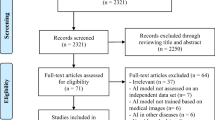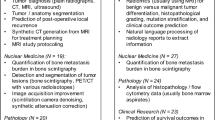Abstract
We aim to conduct a meta-analysis on studies that evaluated the diagnostic performance of artificial intelligence (AI) algorithms in the detection of primary bone tumors, distinguishing them from other bone lesions, and comparing them with clinician assessment. A systematic search was conducted using a combination of keywords related to bone tumors and AI. After extracting contingency tables from all included studies, we performed a meta-analysis using random-effects model to determine the pooled sensitivity and specificity, accompanied by their respective 95% confidence intervals (CI). Quality assessment was evaluated using a modified version of Transparent Reporting of a Multivariable Prediction Model for Individual Prognosis or Diagnosis (TRIPOD) and Prediction Model Study Risk of Bias Assessment Tool (PROBAST). The pooled sensitivities for AI algorithms and clinicians on internal validation test sets for detecting bone neoplasms were 84% (95% CI: 79.88) and 76% (95% CI: 64.85), and pooled specificities were 86% (95% CI: 81.90) and 64% (95% CI: 55.72), respectively. At external validation, the pooled sensitivity and specificity for AI algorithms were 84% (95% CI: 75.90) and 91% (95% CI: 83.96), respectively. The same numbers for clinicians were 85% (95% CI: 73.92) and 94% (95% CI: 89.97), respectively. The sensitivity and specificity for clinicians with AI assistance were 95% (95% CI: 86.98) and 57% (95% CI: 48.66). Caution is needed when interpreting findings due to potential limitations. Further research is needed to bridge this gap in scientific understanding and promote effective implementation for medical practice advancement.




Similar content being viewed by others
Data Availability
The data that support the findings of this study are available from the authors upon reasonable request.
References
Li J, Li S, Li X, Miao S, Dong C, Gao C, et al. Primary bone tumor detection and classification in full-field bone radiographs via YOLO deep learning model. European Radiology. 2022.
Kerr DL, Dial BL, Lazarides AL, Catanzano AA, Lane WO, Blazer DG, 3rd, et al. Epidemiologic and survival trends in adult primary bone tumors of the spine. Spine J. 2019;19(12):1941-9.
Georgeanu VA, Mămuleanu M, Ghiea S, Selișteanu D. Malignant Bone Tumors Diagnosis Using Magnetic Resonance Imaging Based on Deep Learning Algorithms. Medicina (Lithuania). 2022;58(5).
Salazar C, Leite M, Sousa A, Torres J. Correlation between imagenological and histological diagnosis of bone tumors. A retrospective study. Acta Ortop Mex. 2019;33(6):386-90.
Goyal N, Kalra M, Soni A, Baweja P, Ghonghe NP. Multi-modality imaging approach to bone tumors - State-of-the art. J Clin Orthop Trauma. 2019;10(4):687-701.
Hosny A, Parmar C, Quackenbush J, Schwartz LH, Aerts H. Artificial intelligence in radiology. Nat Rev Cancer. 2018;18(8):500-10.
Han SH, Kim KW, Kim S, Youn YC. Artificial Neural Network: Understanding the Basic Concepts without Mathematics. Dement Neurocogn Disord. 2018;17(3):83-9.
Driver CN, Bowles BS, Bartholmai BJ, Greenberg-Worisek AJ. Artificial Intelligence in Radiology: A Call for Thoughtful Application. Clin Transl Sci. 2020;13(2):216-8.
Nair AV, Ramanathan S, Sathiadoss P, Jajodia A, Blair Macdonald D. Barriers to artificial intelligence implementation in radiology practice: What the radiologist needs to know. Radiologia (Engl Ed). 2022;64(4):324-32.
von Schacky CE, Wilhelm NJ, Schäfer VS, Leonhardt Y, Jung M, Jungmann PM, et al. Development and evaluation of machine learning models based on X-ray radiomics for the classification and differentiation of malignant and benign bone tumors. European Radiology. 2022;32(9):6247-57.
Collins GS, Reitsma JB, Altman DG, Moons KG. Transparent reporting of a multivariable prediction model for individual prognosis or diagnosis (TRIPOD): the TRIPOD statement. Annals of internal medicine. 2015;162(1):55-63.
Wolff RF, Moons KG, Riley RD, Whiting PF, Westwood M, Collins GS, et al. PROBAST: a tool to assess the risk of bias and applicability of prediction model studies. Annals of internal medicine. 2019;170(1):51-8.
Dwamena B. MIDAS: Stata module for meta-analytical integration of diagnostic test accuracy studies. 2009.
Harbord RM, Whiting P. Metandi: meta-analysis of diagnostic accuracy using hierarchical logistic regression. The Stata Journal. 2009;9(2):211-29.
Deeks JJ, Macaskill P, Irwig L. The performance of tests of publication bias and other sample size effects in systematic reviews of diagnostic test accuracy was assessed. Journal of clinical epidemiology. 2005;58(9):882-93.
Altameem T. Fuzzy rank correlation-based segmentation method and deep neural network for bone cancer identification. Neural Computing and Applications. 2020;32(3):805-15.
Arana E, Marti-Bonmati L, Bautista D, Paredes R. Calvarial eosinophilic granuloma: Diagnostic models and image feature selection with a neural network. Academic Radiology. 1998;5(6):427-34.
Chianca V, Cuocolo R, Gitto S, Albano D, Merli I, Badalyan J, et al. Radiomic Machine Learning Classifiers in Spine Bone Tumors: A Multi-Software, Multi-Scanner Study. Eur J Radiol. 2021;137:109586.
Consalvo S, Hinterwimmer F, Neumann J, Steinborn M, Salzmann M, Seidl F, et al. Two-Phase Deep Learning Algorithm for Detection and Differentiation of Ewing Sarcoma and Acute Osteomyelitis in Paediatric Radiographs. Anticancer Research. 2022;42(9):4371-80.
Do BH, Langlotz C, Beaulieu CF. Bone Tumor Diagnosis Using a Naïve Bayesian Model of Demographic and Radiographic Features. J Digit Imaging. 2017;30(5):640-7.
Eweje FR, Bao B, Wu J, Dalal D, Liao WH, He Y, et al. Deep Learning for Classification of Bone Lesions on Routine MRI. EBioMedicine. 2021;68:103402.
Gitto S, Cuocolo R, Albano D, Chianca V, Messina C, Gambino A, et al. MRI radiomics-based machine-learning classification of bone chondrosarcoma. Eur J Radiol. 2020;128:109043.
Gitto S, Cuocolo R, van Langevelde K, van de Sande MAJ, Parafioriti A, Luzzati A, et al. MRI radiomics-based machine learning classification of atypical cartilaginous tumour and grade II chondrosarcoma of long bones. EBioMedicine. 2022;75.
He Y, Pan I, Bao B, Halsey K, Chang M, Liu H, et al. Deep learning-based classification of primary bone tumors on radiographs: A preliminary study. EBioMedicine. 2020;62:103121.
Ho NH, Yang HJ, Kim SH, Jung ST, Joo SD. Regenerative semi-supervised bidirectional w-network-based knee bone tumor classification on radiographs guided by three-region bone segmentation. IEEE Access. 2019;7:154277-89.
Lee A, Kim MS, Han SS, Park PG, Lee C, Yun JP. Deep learning neural networks to differentiate Stafne's bone cavity from pathological radiolucent lesions of the mandible in heterogeneous panoramic radiography. PLoS ONE. 2021;16(7 July).
Liu H, Jiao M, Yuan Y, Ouyang H, Liu J, Li Y, et al. Benign and malignant diagnosis of spinal tumors based on deep learning and weighted fusion framework on MRI. Insights Imaging. 2022;13(1):87.
Liu H, Jiao ML, Xing XY, Ou-Yang HQ, Yuan Y, Liu JF, et al. BgNet: Classification of benign and malignant tumors with MRI multi-plane attention learning. Front Oncol. 2022;12:971871.
Liu Y, Yang P, Pi Y, Jiang L, Zhong X, Cheng J, et al. Automatic identification of suspicious bone metastatic lesions in bone scintigraphy using convolutional neural network. BMC Med Imaging. 2021;21(1):131.
Pan D, Liu R, Zheng B, Yuan J, Zeng H, He Z, et al. Using Machine Learning to Unravel the Value of Radiographic Features for the Classification of Bone Tumors. Biomed Res Int. 2021;2021:8811056.
Park CW, Oh SJ, Kim KS, Jang MC, Kim IS, Lee YK, et al. Artificial intelligence-based classification of bone tumors in the proximal femur on plain radiographs: System development and validation. PLoS One. 2022;17(2):e0264140.
Reinus WR, Wilson AJ, Kalman B, Kwasny S. Diagnosis of focal bone lesions using neural networks. Investigative Radiology. 1994;29(6):606-11.
Sharma A, Yadav DP, Garg H, Kumar M, Sharma B, Koundal D. Bone Cancer Detection Using Feature Extraction Based Machine Learning Model. Comput Math Methods Med. 2021;2021:7433186.
Zhao K, Zhang M, Xie Z, Yan X, Wu S, Liao P, et al. Deep Learning Assisted Diagnosis of Musculoskeletal Tumors Based on Contrast-Enhanced Magnetic Resonance Imaging. Journal of Magnetic Resonance Imaging. 2022;56(1):99-107.
Zhao S, Chen B, Chang H, Chen B, Li S. Reasoning discriminative dictionary-embedded network for fully automatic vertebrae tumor diagnosis. Med Image Anal. 2022;79:102456.
Do NT, Jung ST, Yang HJ, Kim SH. Multi-Level Seg-Unet Model with Global and Patch-Based X-ray Images for Knee Bone Tumor Detection. Diagnostics (Basel). 2021;11(4).
Fouad H, Hassanein AS, Soliman AM, Al-Feel H. Internet of Medical Things (IoMT) Assisted Vertebral Tumor Prediction Using Heuristic Hock Transformation Based Gautschi Model–A Numerical Approach. IEEE Access. 2020;8:17299-309.
Gitto S, Bologna M, Corino VDA, Emili I, Albano D, Messina C, et al. Diffusion-weighted MRI radiomics of spine bone tumors: feature stability and machine learning-based classification performance. Radiol Med. 2022.
Gitto S, Cuocolo R, Annovazzi A, Anelli V, Acquasanta M, Cincotta A, et al. CT radiomics-based machine learning classification of atypical cartilaginous tumours and appendicular chondrosarcomas. EBioMedicine. 2021;68:103407.
Ouyang H, Meng F, Liu J, Song X, Li Y, Yuan Y, et al. Evaluation of Deep Learning-Based Automated Detection of Primary Spine Tumors on MRI Using the Turing Test. Front Oncol. 2022;12:814667.
Shung D, Simonov M, Gentry M, Au B, Laine L. Machine Learning to Predict Outcomes in Patients with Acute Gastrointestinal Bleeding: A Systematic Review. Dig Dis Sci. 2019;64(8):2078-87.
Montesinos-López O, Montesinos A, Crossa J. Overfitting, Model Tuning, and Evaluation of Prediction Performance. 2022. p. 109–39.
Liu S, Feng M, Qiao T, Cai H, Xu K, Yu X, et al. Deep Learning for the Automatic Diagnosis and Analysis of Bone Metastasis on Bone Scintigrams. Cancer Manag Res. 2022;14:51-65.
Zheng Q, Yang L, Zeng B, Li J, Guo K, Liang Y, et al. Artificial intelligence performance in detecting tumor metastasis from medical radiology imaging: A systematic review and meta-analysis. EClinicalMedicine. 2021;31:100669.
Younis MH, Abu-Hijleh HA, Aldahamsheh OO, Abualruz A, Thalib L. Meta-Analysis of the Diagnostic Accuracy of Primary Bone and Soft Tissue Sarcomas by 18F-FDG-PET. Med Princ Pract. 2020;29(5):465-72.
Seth N, Seth I, Bulloch G, Siu AHY, Guo A, Chatterjee R, et al. (18) F-FDG PET and PET/CT as a diagnostic method for Ewing sarcoma: A systematic review and meta-analysis. Pediatr Blood Cancer. 2022;69(3):e29415.
Zimmer WD, Berquist TH, McLeod RA, Sim FH, Pritchard DJ, Shives TC, et al. Bone tumors: magnetic resonance imaging versus computed tomography. Radiology. 1985;155(3):709-18.
van Dyk DA, Meng X-L. The Art of Data Augmentation. Journal of Computational and Graphical Statistics. 2001;10(1):1-50.
Torrey L, Shavlik J. Transfer learning. Handbook of Research on Machine Learning Applications. 2009.
Author information
Authors and Affiliations
Contributions
Soheil Mohammadi and Mohammad Amin Salehi designed the project, contributed to protocol development, literature search, screening, data extraction, and writing of the original draft. Hamid Harandi contributed to writing of the original draft. Seyed Sina Zakavi and Ali Jahanshahi contributed to screening and protocol development. Mohammad Shahrabi Farahani contributed to the writing of the original draft. Jim S. Wu encouraged and supervised the project, reviewed the manuscript, and contributed to the writing of the original and final draft.
Corresponding author
Ethics declarations
Conflict of Interest
The authors declare no competing interests.
Additional information
Publisher's Note
Springer Nature remains neutral with regard to jurisdictional claims in published maps and institutional affiliations.
Supplementary Information
Below is the link to the electronic supplementary material.
Rights and permissions
Springer Nature or its licensor (e.g. a society or other partner) holds exclusive rights to this article under a publishing agreement with the author(s) or other rightsholder(s); author self-archiving of the accepted manuscript version of this article is solely governed by the terms of such publishing agreement and applicable law.
About this article
Cite this article
Salehi, M.A., Mohammadi, S., Harandi, H. et al. Diagnostic Performance of Artificial Intelligence in Detection of Primary Malignant Bone Tumors: a Meta-Analysis. J Digit Imaging. Inform. med. 37, 766–777 (2024). https://doi.org/10.1007/s10278-023-00945-3
Received:
Revised:
Accepted:
Published:
Issue Date:
DOI: https://doi.org/10.1007/s10278-023-00945-3




